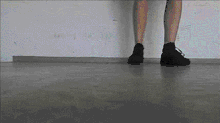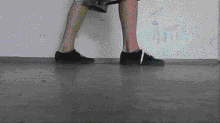Melbourne shuffle
The Melbourne shuffle is a rave dance that developed in the 1980s.[1] Typically performed to electronic music, the dance originated in the Melbourne rave scene, and was popular in the late 1980s and 1990s.[2] The dance moves involve a fast heel-and-toe movement or T-step, combined with a variation of the running man coupled with a matching arm action.[1] The dance is improvised and involves "repeatedly shuffling your feet inwards, then outwards, while thrusting your arms up and down, or side to side, in time with the beat". Other moves can be incorporated including 360-degree spins and jumps and slides.[2] Popular Melbourne clubs during the dance's heyday included Hard Kandy, Bubble, Xpress at Chasers, Heat, Mercury Lounge, Viper, Two Tribes at Chasers and PHD.[1] Melbourne's first techno dance parties Biology, Hardware and Every Picture Tells A Story were popular with Melbourne Shuffle innovators.[3]
| Melbourne shuffle | |
|---|---|
| Dance type | Rave dance |
| Year | 1980s—present |
| Country | Australia |
| Related topics | |
In 2009, the German hard dance group Scooter featured dancers Pae (Missaghi Peyman) and Sarah Miatt performing the Melbourne shuffle on the streets of Melbourne (Australia) in the music video of their single J'adore Hardcore.
In 2014, researchers at Brown University named a new computer security algorithm after the Melbourne shuffle. The algorithm deletes traces of users' access on cloud servers by shuffling the location of data on those servers[4]
UK and Netherlands
In 2012, the Melbourne shuffle became popular in London. In the UK, the style has been referred to simply as "shuffling".[5]
The Melbourne shuffle was reported to have made an appearance on the Netherlands dance scene in 2014, where it was referred to in derogatory terms as "konijnendans" or the "rabbit dance".[6]
Technique


The underlying dance moves involve the T-step, combined with a variation of the running man.[1] The dance is improvised and involves "repeatedly shuffling your feet inwards, then outwards, while thrusting your arms up and down, or side to side, in time with the beat". 360-degree spins, jumps and slides are also incorporated.[2] It is often associated with another style of dance, "cutting shapes."
Some dancers sprinkle talcum powder or apply liquid to the floor beneath their feet to help them slide more easily.[2]
References
- Fazal, Mahmood. "Which Is Sicker: Melbourne Shuffle or Sydney Gabber?". Vice. Vice Media. Retrieved 14 March 2019.
- Tomazin, Farrah; Donovan, Patrick; Mundell, Meg (7 December 2002). "Dance Trance". The Age. The Age Company Ltd.
- Stanmore, Carl. "Australia's Forgotten Rave Culture – Who Did It Better, Sydney or Melbourne?". The DJ Revolution. The DJ Revoltion. Retrieved 22 June 2021.
- "'Melbourne Shuffle' secures data in the cloud". American Association for the Advancement of Science. 10 July 2014.
- "Shuffling: the War at the Heart of London's New Dance Scene". vice.com/en_uk. Retrieved 20 July 2015.
- Schwartzberg, Lauren. "The Rabbit Dance Is Pissing Off Everyone in the Netherlands". Vice. Vice Media. Retrieved 14 March 2019.
Further reading
- Pagett, Matt (2008). "Melbourne Shuffle". The Best Dance Moves in the World - Ever! 100 New and Classic Moves and How to Bust Them. Chronicle Books. pp. 28–29. ISBN 978-0-811-86303-2.